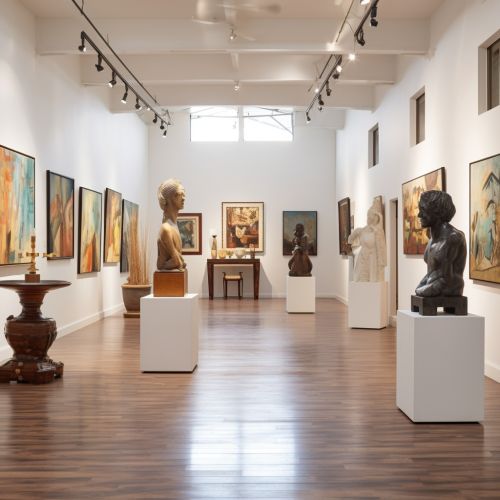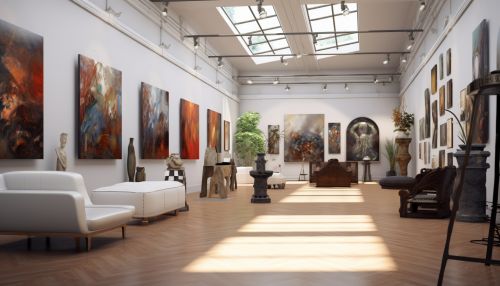Art Exhibition
Overview
An Art Exhibition is a space where artworks are displayed for public viewing. These exhibitions can take place in a variety of venues, from traditional art galleries and museums to more unconventional spaces like warehouses or outdoor parks. The purpose of an art exhibition is to showcase the work of individual artists or groups of artists, to promote new artistic trends, or to explore specific themes or topics.
History
The concept of art exhibitions dates back to the ancient civilizations of Egypt, Greece, and Rome, where artworks were often displayed in public spaces for communal appreciation. However, the modern concept of an art exhibition, as we understand it today, originated in the 18th century with the establishment of the Royal Academy of Arts in London in 1768. The Academy organized annual exhibitions, known as the "Summer Exhibition", where artworks selected by a committee were displayed to the public. This model of a curated, public art exhibition soon spread across Europe and North America, and remains a standard practice in the art world today.


Types of Art Exhibitions
Art exhibitions can be categorized into several types based on their content, purpose, and organization.
Solo Exhibition
A Solo Exhibition is an exhibition where the works of a single artist are displayed. These exhibitions provide an in-depth look at an artist's oeuvre, showcasing their artistic development and thematic concerns. Solo exhibitions can be retrospective, presenting the artist's work over a period of time, or they can focus on the artist's most recent works.
Group Exhibition
A Group Exhibition brings together works by two or more artists. These exhibitions can be organized around a specific theme, medium, or concept that links the artworks together. Group exhibitions can also be used to showcase the work of emerging artists or to present a survey of a particular art movement or trend.
Juried Exhibition
In a Juried Exhibition, artworks are selected for display by a panel of judges, or jurors. These exhibitions are often competitive, with artists submitting their work for consideration and a selection of these works being chosen for the exhibition. Juried exhibitions can provide opportunities for artists to gain recognition and prizes for their work.
Invitational Exhibition
An Invitational Exhibition is an exhibition where artists are directly invited by the curator or the hosting institution to participate. These exhibitions often focus on a specific theme or concept and include works by artists whose practice aligns with this focus.
Traveling Exhibition
A Traveling Exhibition is an exhibition that is designed to be shown in multiple venues. These exhibitions are often organized by a single institution and then travel to other museums or galleries, allowing the exhibition to reach a wider audience.
Curatorial Process
The process of organizing an art exhibition involves several stages, from the initial concept to the final installation of the artworks. This process is typically overseen by a curator, who is responsible for selecting the artworks, developing the exhibition's theme or concept, and arranging the display of the works.
Concept Development
The first stage in the curatorial process is the development of the exhibition's concept. This involves defining the theme or focus of the exhibition, researching relevant artists and artworks, and formulating the overall vision for the exhibition.
Artwork Selection
Once the concept has been developed, the curator selects the artworks that will be included in the exhibition. This selection process can involve visiting artists' studios, reviewing portfolios, and assessing the relevance of each artwork to the exhibition's theme.
Exhibition Design
The design of the exhibition involves determining the layout of the artworks within the exhibition space. This includes deciding on the placement of each artwork, considering the flow of the exhibition, and ensuring that the display of the artworks supports the overall concept of the exhibition.
Installation
The final stage of the curatorial process is the installation of the artworks. This involves physically placing the artworks in the exhibition space, adjusting lighting and signage, and ensuring that the exhibition is ready for public viewing.
Impact of Art Exhibitions
Art exhibitions play a crucial role in the art world and have a significant impact on artists, viewers, and the broader cultural landscape. They provide a platform for artists to showcase their work, gain recognition, and potentially sell their artworks. For viewers, art exhibitions offer an opportunity to engage with art, learn about different artistic practices and trends, and gain a deeper appreciation for the arts.
Art exhibitions also contribute to cultural discourse, sparking conversations about various social, political, and cultural issues. They can challenge viewers' perceptions, provoke thought, and inspire creativity.
